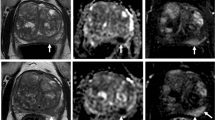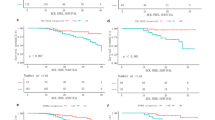Abstract
Purpose
To investigate computed tomography (CT)-based prediction model for identifying patients with high probability of non-muscle-invasive bladder cancer (NMIBC).
Methods
This retrospective study evaluated 147 consecutive patients who underwent contrast-enhanced CT and surgery for bladder cancer. Using corticomedullary-to-portal venous phase images, two independent readers analyzed bladder muscle invasion, tumor stalk, and tumor size, respectively. Three-point scale (i.e., from 0 to 2) was applied for assessing the suspicion degree of muscle invasion or tumor stalk. A multivariate prediction model using the CT parameters for achieving high positive predictive value (PPV) for NMIBC was investigated. The PPVs from raw data or 1000 bootstrap resampling and inter-reader agreement using Gwet’s AC1 were analyzed, respectively.
Results
Proportion of patients with NMIBC was 81.0% (119/147). The CT criteria of the prediction model were as follows: (a) muscle invasion score < 2; (b) tumor stalk score > 0; and (c) tumor size < 3 cm. From the raw data, PPV of the model for NMIBC was 92.7% (51/55; 95% confidence interval [CI] 82.4–98.0) in reader 1 and 93.3% (42/45; 95% CI 81.7–98.6) in reader 2. From the bootstrap data, PPV was 92.8% (95% CI 85.2–98.3) in reader 1 and 93.4% (95% CI 84.9–99.9) in reader 2. The model’s AC1 was 0.753 (95% CI 0.647–0.859).
Conclusion
The current CT-derived prediction model demonstrated high PPV for identifying patients with NMIBC. Depending on CT findings, approximately 30% of patients with bladder cancer may have a low need for additional MRI for interpreting vesical imaging-reporting and data system.
Graphical abstract






Similar content being viewed by others
References
Panebianco V, Narumi Y, Altun E, Bochner BH, Efstathiou JA, Hafeez S, Huddart R, Kennish S, Lerner S, Montironi R, Muglia VF, Salomon G, Thomas S, Vargas HA, Witjes JA, Takeuchi M, Barentsz J, Catto JWF (2018) Multiparametric Magnetic Resonance Imaging for Bladder Cancer: Development of VI-RADS (Vesical Imaging-Reporting And Data System). Eur Urol 74:294-306. https://doi.org/10.1016/j.eururo.2018.04.029
Ueno Y, Takeuchi M, Tamada T, Sofue K, Takahashi S, Kamishima Y, Hinata N, Harada K, Fujisawa M, Murakami T (2019) Diagnostic Accuracy and Interobserver Agreement for the Vesical Imaging-Reporting and Data System for Muscle-invasive Bladder Cancer: A Multireader Validation Study. Eur Urol 76:54-56. https://doi.org/10.1016/j.eururo.2019.03.012
Woo S, Panebianco V, Narumi Y, Del Giudice F, Muglia VF, Takeuchi M, Ghafoor S, Bochner BH, Goh AC, Hricak H, Catto JWF, Vargas HA (2020) Diagnostic Performance of Vesical Imaging Reporting and Data System for the Prediction of Muscle-invasive Bladder Cancer: A Systematic Review and Meta-analysis. Eur Urol Oncol 3:306-315. https://doi.org/10.1016/j.euo.2020.02.007
Luo C, Huang B, Wu Y, Chen J, Chen L (2020) Use of Vesical Imaging-Reporting and Data System (VI-RADS) for detecting the muscle invasion of bladder cancer: a diagnostic meta-analysis. Eur Radiol 30:4606-4614. https://doi.org/10.1007/s00330-020-06802-z
Feng Y, Zhong K, Chen R, Zhou W (2022) Diagnostic accuracy of vesical imaging-reporting and data system (VI-RADS) for the detection of muscle-invasive bladder cancer: a meta-analysis. Abdom Radiol (NY) 47:1396-1405. https://doi.org/10.1007/s00261-022-03449-w
Babjuk M, Burger M, Capoun O, Cohen D, Comperat EM, Dominguez Escrig JL, Gontero P, Liedberg F, Masson-Lecomte A, Mostafid AH, Palou J, van Rhijn BWG, Roupret M, Shariat SF, Seisen T, Soukup V, Sylvester RJ (2022) European Association of Urology Guidelines on Non-muscle-invasive Bladder Cancer (Ta, T1, and Carcinoma in Situ). Eur Urol 81:75-94. https://doi.org/10.1016/j.eururo.2021.08.010
Witjes JA, Bruins HM, Cathomas R, Comperat EM, Cowan NC, Gakis G, Hernandez V, Linares Espinos E, Lorch A, Neuzillet Y, Rouanne M, Thalmann GN, Veskimae E, Ribal MJ, van der Heijden AG (2021) European Association of Urology Guidelines on Muscle-invasive and Metastatic Bladder Cancer: Summary of the 2020 Guidelines. Eur Urol 79:82-104. https://doi.org/10.1016/j.eururo.2020.03.055
Vikram R, Sandler CM, Ng CS (2009) Imaging and staging of transitional cell carcinoma: part 1, lower urinary tract. AJR Am J Roentgenol 192:1481-1487. https://doi.org/10.2214/AJR.08.1318
Lee CH, Tan CH, Faria SC, Kundra V (2017) Role of Imaging in the Local Staging of Urothelial Carcinoma of the Bladder. AJR Am J Roentgenol 208:1193-1205. https://doi.org/10.2214/AJR.16.17114
Choi SJ, Park KJ, Lee G, Kim MH, Kim JK (2020) Urothelial phase CT for assessment of pathologic complete response after neoadjuvant chemotherapy in muscle-invasive bladder cancer. Eur J Radiol 126:108902. https://doi.org/10.1016/j.ejrad.2020.108902
Metser U, Goldstein MA, Chawla TP, Fleshner NE, Jacks LM, O’Malley ME (2012) Detection of urothelial tumors: comparison of urothelial phase with excretory phase CT urography--a prospective study. Radiology 264:110-118. https://doi.org/10.1148/radiol.12111623
Helenius M, Brekkan E, Dahlman P, Lonnemark M, Magnusson A (2015) Bladder cancer detection in patients with gross haematuria: Computed tomography urography with enhancement-triggered scan versus flexible cystoscopy. Scand J Urol 49:377-381. https://doi.org/10.3109/21681805.2015.1026937
Jinzaki M, Kikuchi E, Akita H, Sugiura H, Shinmoto H, Oya M (2016) Role of computed tomography urography in the clinical evaluation of upper tract urothelial carcinoma. Int J Urol 23:284-298. https://doi.org/10.1111/iju.13032
Takeuchi M, Sasaki S, Ito M, Okada S, Takahashi S, Kawai T, Suzuki K, Oshima H, Hara M, Shibamoto Y (2009) Urinary bladder cancer: diffusion-weighted MR imaging--accuracy for diagnosing T stage and estimating histologic grade. Radiology 251:112-121. https://doi.org/10.1148/radiol.2511080873
Chang SS, Boorjian SA, Chou R, Clark PE, Daneshmand S, Konety BR, Pruthi R, Quale DZ, Ritch CR, Seigne JD, Skinner EC, Smith ND, McKiernan JM (2016) Diagnosis and Treatment of Non-Muscle Invasive Bladder Cancer: AUA/SUO Guideline. J Urol 196:1021-1029. https://doi.org/10.1016/j.juro.2016.06.049
Parikh R, Mathai A, Parikh S, Chandra Sekhar G, Thomas R (2008) Understanding and using sensitivity, specificity and predictive values. Indian J Ophthalmol 56:45-50. https://doi.org/10.4103/0301-4738.37595
Ward RD, Tanaka H, Campbell SC, Remer EM (2018) 2017 AUA Renal Mass and Localized Renal Cancer Guidelines: Imaging Implications. Radiographics 38:2021-2033. https://doi.org/10.1148/rg.2018180127
Ueno Y, Tamada T, Takeuchi M, Sofue K, Takahashi S, Kamishima Y, Urase Y, Kido A, Hinata N, Harada K, Fujisawa M, Miyaji Y, Murakami T (2021) VI-RADS: Multiinstitutional Multireader Diagnostic Accuracy and Interobserver Agreement Study. AJR Am J Roentgenol 216:1257-1266. https://doi.org/10.2214/AJR.20.23604
Han K, Song K, Choi BW (2016) How to Develop, Validate, and Compare Clinical Prediction Models Involving Radiological Parameters: Study Design and Statistical Methods. Korean J Radiol 17:339-350. https://doi.org/10.3348/kjr.2016.17.3.339
Ialongo C (2019) Confidence interval for quantiles and percentiles. Biochem Med (Zagreb) 29:010101. https://doi.org/10.11613/BM.2019.010101
Dettori JR, Norvell DC (2020) Kappa and Beyond: Is There Agreement? Global Spine J 10:499-501. https://doi.org/10.1177/2192568220911648
Wongpakaran N, Wongpakaran T, Wedding D, Gwet KL (2013) A comparison of Cohen’s Kappa and Gwet’s AC1 when calculating inter-rater reliability coefficients: a study conducted with personality disorder samples. BMC Med Res Methodol 13:61. https://doi.org/10.1186/1471-2288-13-61
Shampain KL, Shankar PR, Troost JP, Galantowicz ML, Pampati RA, Schoenheit TR, Shlensky DA, Barkmeier D, Curci NE, Kaza RK, Khalatbari S, Davenport MS (2022) Interrater Agreement of Bosniak Classification Version 2019 and Version 2005 for Cystic Renal Masses at CT and MRI. Radiology 302:357-366. https://doi.org/10.1148/radiol.2021210853
Van Der Molen AJ, Cowan NC, Mueller-Lisse UG, Nolte-Ernsting CC, Takahashi S, Cohan RH, Radiology CTUWGotESoU (2008) CT urography: definition, indications and techniques. A guideline for clinical practice. Eur Radiol 18:4-17. https://doi.org/10.1007/s00330-007-0792-x
O’Connor OJ, Maher MM (2010) CT urography. AJR Am J Roentgenol 195:W320-324. https://doi.org/10.2214/AJR.10.4198
Kim B, Semelka RC, Ascher SM, Chalpin DB, Carroll PR, Hricak H (1994) Bladder tumor staging: comparison of contrast-enhanced CT, T1- and T2-weighted MR imaging, dynamic gadolinium-enhanced imaging, and late gadolinium-enhanced imaging. Radiology 193:239-245. https://doi.org/10.1148/radiology.193.1.8090898
Jazayeri SB, Dehghanbanadaki H, Hosseini M, Taghipour P, Bazargani S, Thomas D, Feibus A, Sarabchian E, Bacchus MW, Di Valerio EA, Bandyk M, Balaji KC (2022) Inter-reader reliability of the vesical imaging-reporting and data system (VI-RADS) for muscle-invasive bladder cancer: a systematic review and meta-analysis. Abdom Radiol (NY) 47:4173-4185. https://doi.org/10.1007/s00261-022-03669-0
Wang HJ, Pui MH, Guan J, Li SR, Lin JH, Pan B, Guo Y (2016) Comparison of Early Submucosal Enhancement and Tumor Stalk in Staging Bladder Urothelial Carcinoma. AJR Am J Roentgenol 207:797-803. https://doi.org/10.2214/AJR.16.16283
Razik A, Das CJ, Sharma S, Seth A, Srivastava DN, Mathur S, Kumar R, Gupta AK (2018) Diagnostic performance of diffusion-weighted MR imaging at 3.0 T in predicting muscle invasion in urinary bladder cancer: utility of evaluating the morphology of the reactive tumor stalk. Abdom Radiol (NY) 43:2431-2441. https://doi.org/10.1007/s00261-018-1458-7
Brady SL, Trout AT, Somasundaram E, Anton CG, Li Y, Dillman JR (2021) Improving Image Quality and Reducing Radiation Dose for Pediatric CT by Using Deep Learning Reconstruction. Radiology 298:180-188. https://doi.org/10.1148/radiol.2020202317
Han WK, Na JC, Park SY (2020) Low-dose CT angiography using ASiR-V for potential living renal donors: a prospective analysis of image quality and diagnostic accuracy. Eur Radiol 30:798-805. https://doi.org/10.1007/s00330-019-06423-1
Panebianco V, Pecoraro M, Del Giudice F, Takeuchi M, Muglia VF, Messina E, Cipollari S, Giannarini G, Catalano C, Narumi Y (2022) VI-RADS for Bladder Cancer: Current Applications and Future Developments. J Magn Reson Imaging 55:23-36. https://doi.org/10.1002/jmri.27361
Silverman SG, Leyendecker JR, Amis ES, Jr. (2009) What is the current role of CT urography and MR urography in the evaluation of the urinary tract? Radiology 250:309-323. https://doi.org/10.1148/radiol.2502080534
An T, Kwon GY, Min JH, Park SY (2020) Ureteral cancer: Complete ureteral obstruction on computed tomography urography is associated with periureteral fat invasion. Eur J Radiol 130:109198. https://doi.org/10.1016/j.ejrad.2020.109198
Saito W, Amanuma M, Tanaka J, Heshiki A (2000) Histopathological analysis of a bladder cancer stalk observed on MRI. Magn Reson Imaging 18:411-415. https://doi.org/10.1016/s0730-725x(00)00124-7
Chen L, Zhang G, Xu L, Zhang X, Zhang J, Bai X, Jin R, Mao L, Xiao X, Li X, Xie Y, Jin Z, Sun H (2023) Preoperative CT features to predict risk stratification of non-muscle invasive bladder cancer. Abdom Radiol (NY) 48:659-668. https://doi.org/10.1007/s00261-022-03730-y
Acknowledgments
None.
Funding
None.
Author information
Authors and Affiliations
Corresponding author
Ethics declarations
Conflict of interest
The authors declared no potential conflicts of interest with respect to the research, authorship, and/or publication of this article.
Additional information
Publisher's Note
Springer Nature remains neutral with regard to jurisdictional claims in published maps and institutional affiliations.
Supplementary Information
Below is the link to the electronic supplementary material.
Rights and permissions
Springer Nature or its licensor (e.g. a society or other partner) holds exclusive rights to this article under a publishing agreement with the author(s) or other rightsholder(s); author self-archiving of the accepted manuscript version of this article is solely governed by the terms of such publishing agreement and applicable law.
About this article
Cite this article
Kang, K.A., Kim, M.J., Kwon, G.Y. et al. Computed tomography-based prediction model for identifying patients with high probability of non-muscle-invasive bladder cancer. Abdom Radiol 49, 163–172 (2024). https://doi.org/10.1007/s00261-023-04069-8
Received:
Revised:
Accepted:
Published:
Issue Date:
DOI: https://doi.org/10.1007/s00261-023-04069-8




